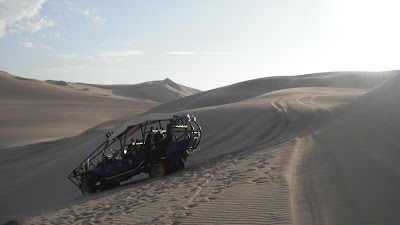Once upon a time, Huacachina was a playground of the
Peruvian elite, a veritable oasis where they would come to escape the drudgery
of everyday life. Nowadays, it’s more of a tourist trap – the tiny lake in the
middle of a sea of sand dunes is lined three-deep with bars advertising 5x1
happy hours and hostels housing tipsy young tourists. It’s definitely not what
you’d call a cultural hub. But you only need to head over the first dune to
realize what drew the Peruvians originally and the tourists today – a gorgeous,
untouched expanse of silk-smooth sand dunes, where, if you time it right, you
can see a sunset that will take your breath away.
 |
| Sun setting over the sand dunes in Huacachina, Peru |
We decided to spend our last four days in South America in
Huacachina, where, in addition to the dunes, we knew we’d find sunshine and
pisco sours by the dozen. Which we did. Lying by the pool at our hotel, El
Huacachinero, sipping pisco sours, it was hard to believe it was just barely
spring in Peru (the temperature dropped by about 15 degrees as soon as the sun
went down though, which made it a bit more believable).
 |
| El Huacachinero Hotel in Huacachina, Peru |
By day two, we'd filled our lounging quota and were itching for more adventure, so we decided to head to the
dunes. We went out in a big buggy with several others from our hotel on the last
tour of the day in hopes of catching the sunset. Our other goal was to attempt
sandboarding. We got lucky, and were able to tick off both.
 |
| Endless sand dunes, Huacachina, Peru |
 |
| Looking back towards Huacachina |
After tearing around the dunes in the buggy for a few
minutes, our guide stopped us on the edge of an excitingly steep dune and
handed us the sandboards. Using the term sandboard is being generous, as they
were really just slabs of plywood coated in plastic, with Velcro straps. Real
sandboarders (yes, those exist) use modified snowboards, which are lighter and
much more flexible, and boots. We’re both experienced snowboarders at home, so despite
the minimalist equipment, we were determined to try it. Turns out sliding down
a steep sand dune on a slab of plywood isn’t as easy as it looks.
 |
| We're a little sandy |
 |
| That's me at the top, on my board |
After a few hilariously bad tumbles, and the sand-related
death of my point-and-shoot camera, we both managed to master it. Video proof,
of yours truly:
We then parked our trusty steed to watch the sun set over
the dunes, which was truly stunning.
 |
| Sunset, x100 |
Although it was definitely one of the most touristy experiences
of our trip, it was a ton of fun and I’d do it again in a second (probably with a proper sandboard).
 |
| Cartwheels in the Huacachina dunes |
Our final day in Huacachina (and sadly, final full day in Peru) was all about the
area’s other main tourist attraction: wineries. The weather and location mean
that only grapes for sweet wine – and, of course, the fuel for Peru’s national
drink, the Pisco Sour – will grow. Pisco is actually made from fermented grapes
(similar to brandy), and carries a punch of about 40% ABV. On the tour booked through
our hotel, we visited three wineries, starting with the large commercial
version and ending with the quirky (emphasis on quirky) local bodega.
 |
| Bodegas Vista Alegre, Ica, Peru |
 |
| 150 year old wine barrels at Bodegas Vista Alegre |
 |
| Surveying the vines at Bodegas Vista Alegre |
Bodegas Vista Alegre is a large-scale production winery, and their tour was similarly dry and impersonal. The wine wasn't bad though. Our second stop was a much smaller operation with more of a welcoming feel. The tour guide was great, and we got to
try three different types of Pisco, as well as their chocolate cream version
(which tasted like Bailey’s, but better).
 |
| Family wineries in Ica, Peru |
The last stop was one of those places that is truly one of a
kind. Rather than a tour from the winery staff, our hilarious driver Guillaume
just walked us right into the back of the bodega, where we were free to sample from dozens upon
dozens of these traditional clay vessels filled with different kinds of sweet
wine and pisco:
To extract the wine from the vessels, you dip in a bamboo
rod with a section hollowed out, fill it, and then pour it into shot glasses.
After “a few” samples, we started checking out the bizarre décor,
which included such gems as:
After an adventurous ride back to a soundtrack of Madonna (which
was somehow fitting), we headed out for one last night on the town with a local
who worked at one of the bars around the lake. I won't disclose the full details of the evening, other than noting it involved a lot of pisco, salsa dancing and crashing a Peruvian's 18th birthday party. Oh, and a few of these:
 |
| In Peru, Cusquenas flow like water |
 |
| No caption needed. |
The next morning, we bid a foggy adieu to the oasis and boarded the bus towards Lima and our flight home, bringing our South American journey to a close. I can say without hesitation that the 25 days we spent in Peru and Bolivia were some of the best of my life so far. I'm already counting the days until I can return south - Chile and Argentina next, methinks?
More South America posts:
Salar de Uyuni (Bolivian salt flats)





















No comments:
Post a Comment